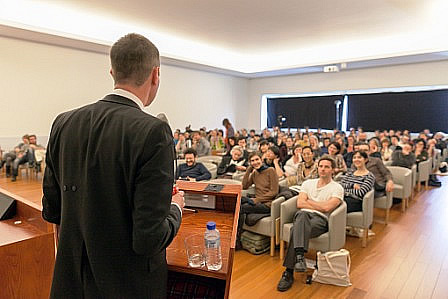European Network of Public Art Producers,
Mar 22, 2012 - Mar 24, 2012
Bilbao, Spain
Going Public – Telling it as it is?
by Jaime Cuenca
Either way, labels are unimportant as long as the aim is clear. Despite the unfortunate name, there can be no doubt that the type of art in which the ENPAP engages is a form of art that seeks to resist, on its own ground, strategies to appropriate that commonality. I think this is the underlying idea of the attempts to define it that we heard in Bilbao and, better still, were embodied in practice through the two main projects that marked the beginning of the symposium on March 22. In fact, different ways of responding, through the art of the common, to the other two approaches of aesthetic intervention -- monuments and marketing-- could be seen in Itziar Barrios’ (We could have had it all) and Alex Reynolds’ productions. Itziar Barrios made an audiovisual installation for the Teatro Arriaga and the square opposite the theater, based on two references as different from each other in principle as the Occupy Wall Street movement and the singer Adele. He was particularly interested in Adele’s way of eliciting cathartic reactions from the audience when she points the microphone at the crowd and encourages it to sing; from the Occupy Wall Street movement he took the idea of the people’s mike, which consists of repeating the speaker’s words in chorus in order to get around the prohibition of sound amplifiers. The project’s two references highlight the voice of the common, which manages to express itself by resisting political obstacles and the passive role encouraged by the entertainment industry. The way the installation was set up recreated an assembly in the square, which is exactly where the logic of monuments seeks to exercise its role of appropriation. Here Itziar Barrios was being consciously and deliberately anti-monumental. The whole project can thus be interpreted as a form of aesthetic resistance to the political capitalization of the communal voice by a minority.
In turn, Alex Reynolds’ performance was held in the shop window of a disused video club. In it were three Foley artists, i.e., professionals who recreate sounds for cinematic effect. With the aid of a motley assortment of utensils and working from inside the former video club, the Foley artists imitated the sound of the actions they could see taking place in the street outside the shop window, thereby inverting the customary sense of the flow of attention: for once it was the interior that showed interest in the exterior. It was a way of responding to those micro marketing actions that are increasingly making use of artistic means (DJs, actors, etc.) to try to call the attention of a jaded urban public and incite it to buy things. Here the attention focused on passers-by, who became ephemeral movie stars: their everyday actions, framed by the screen formed by the shop window, came across as being worthy of a professional sound post-production job. The dignity of common life in the city was thus regained and enhanced by resorting to the very strategies that marketing seeks to appropriate it for its own ends.
In my view, the ENPAP could not have chosen a better way to launch a symposium devoted to a reflection on public art. Reynolds’ and Barrios’ works not only perfectly embody what the concept can communicate (when subjected to criticism), but also help to temper the naïve aspirations of what is generally meant by public art. The mere fact that it is conducted outside the sphere of traditional art institutions does not automatically invest it with magical social effectiveness. Believing that means not understanding, in the slightest, the relationship that artists and viewers are asked to engage in through art. If any forms of aesthetic intervention are indeed imbued with a certain magical effectiveness, these would be the logic of monuments and marketing. What an art of the common should precisely seek to do is shatter that magic, to halt the automatism of aesthetic awareness that is expropriating what belongs to all. An art that embraces this endeavor may not be spectacular or lead to instant gratification, but it is more essential today than ever.
|







